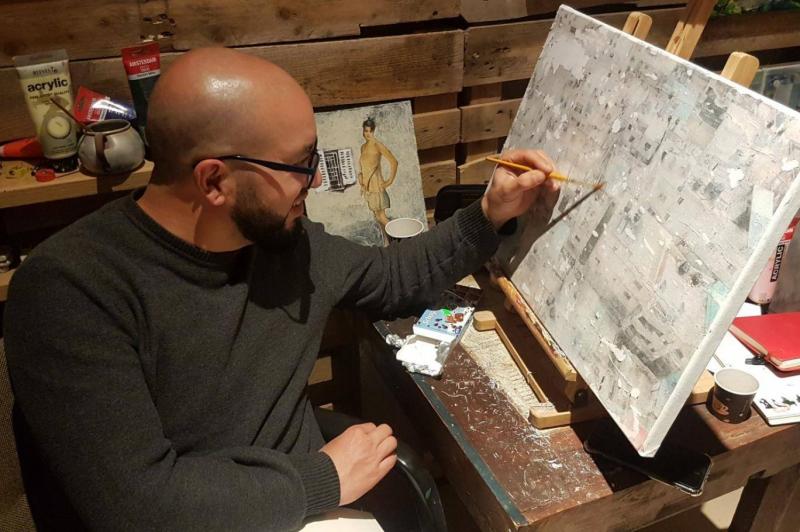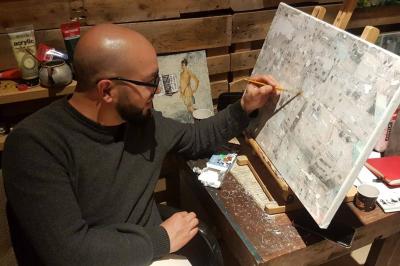A live experience for art enthusiasts is being offered by the "Zawyeh" gallery in the West Bank, allowing them to walk through the alleys of the Al-Am'ari camp near Ramallah and tour the works of artist Alaa Al-Baba, speaking with him inside his studio in the camp where he was born and raised. The exhibition features 48 artworks of various sizes, the result of five years of work on artistic projects that Al-Baba (38 years old) has dedicated to exploring the camp from all its angles.
Gallery director Youssef Darras stated, "We wanted to do something different, focusing the experience on the artist and his workspace. This is the first event in a series of open exhibitions that will take place throughout the year." He added, "We started with Alaa Al-Baba, and his presence in the camp adds to the artistic experience, allowing visitors to walk in the atmosphere of the camp leading to the exhibition, which concludes its activities today, Sunday."
Darras continued, "We sought to provide a completely new experience for art lovers and collectors, allowing for personal interaction with the artist, and letting them see the place where he produces his works that focus on the camp in various ways, giving it color, life, and hope." The Zawyeh gallery's initiative is part of a larger project aimed at highlighting the works of several artists in their own studios through a series of exhibitions held in the artists' workshops.
According to a statement from the gallery, Alaa Al-Baba's works "focus on daily life in the camp... and reconstruct the details of the camp from an architectural perspective using striking colors that reflect his personal vision and experience in the camp where he grew up." The statement added, "Al-Baba's style ranges between expressionism and realism, showcasing the camp in his paintings through various comparisons and approaches with its modern architectural surroundings, indicating the transformations that have affected Palestinian society... which can be observed in the buildings, towers, and massive advertising billboards adjacent to the camp that has maintained its identity over the years."
He plans to promote these works through his network of connections in Ramallah and Dubai to support the artist and encourage production, creating a network of interaction between him and his audience and supportive environment. Artist Alaa Al-Baba pointed out that he has been working on the camp's architectural form for five years, adding vibrant colors to it. He remarked, "The paintings speak for themselves and do not need explanation or clarification; I aim to change the stereotype that the camp is gray and life there is difficult."
He explained that some paintings reflect his personal identity as someone born and raised in the camp, stating, "I worked on my personality through the symbolism of the fish." He added, "Why did I choose the fish? Because I am a child of the shore, and being in this camp took me away from the coast and the coastal area." He went on to say, "The main idea stems from the fact that the United Nations distributed sardine cans to the residents, and the camp resembles a can of sardines, with the fish representing a shift to a virtual environment."
Al-Baba is preparing to participate with his artworks depicting the camp and life within it in exhibitions in the Netherlands and the United States in the coming period.




